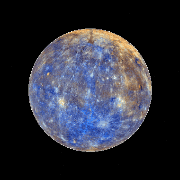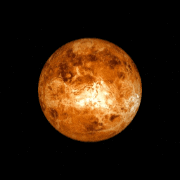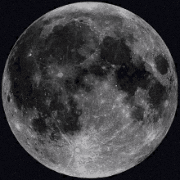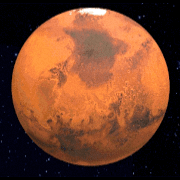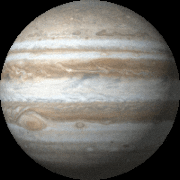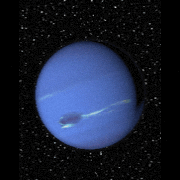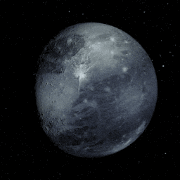Neptune — detailed summary
Basic facts
Type: Ice giant (outer planet).
Mean distance from Sun: ~4.50 billion km (30.1 AU).
Orbital period: ~164.8 Earth years.
Rotation period (sidereal): ~16.11 hours.
Equatorial radius: ~24,764 km; polar radius: ~24,341 km (slightly oblate).
Mass: ~1.02 × 10^26 kg (≈17.1 Earth masses).
Average density: ~1.64 g/cm^3.
Effective temperature: ≈59 K; cloud-top temperatures ~55–60 K.
Appearance and atmosphere
Visual appearance: deep azure-blue color from methane absorption of red light; more visually active than Uranus with pronounced cloud features and storms visible in visible and infrared wavelengths.
Atmospheric composition: hydrogen (~80%), helium (~19%), methane (~1.5–2% in upper atmosphere), with trace amounts of water, ammonia, hydrogen sulfide and hydrocarbons deeper down.
Clouds and haze: high-altitude methane ice clouds and deeper clouds likely composed of hydrogen sulfide and water; photochemical hazes produce layered structures.
Weather and dynamics: extremely active weather with the fastest winds in the Solar System (up to ~2,100 km/h or ~580 m/s), large vortices (e.g., the Great Dark Spot observed by Voyager 2), and evolving storm systems. Strong latitudinal banding and jet streams.
Internal structure
Layered structure: outer hydrogen/helium atmosphere over a massive “ice” mantle composed of water, ammonia, and methane in ionic or supercritical form, surrounding a dense rocky/icy core.
Heat: Neptune emits significantly more internal heat than it receives from the Sun — about 2.6 times the energy it gets — indicating vigorous internal heat transport; mechanism not fully understood but may involve leftover formation heat, ongoing contraction, or internal differentiation.
Magnetic field
Off-centered and tilted: Neptune’s magnetic dipole is tilted (~47°) relative to its rotation axis and offset from the planet’s center — similar to Uranus — producing an irregular, non-dipolar magnetosphere.
Magnetosphere: interacts with solar wind to create aurorae and complex charged-particle environments; shows time-variable dynamics.
Rotation and seasons
Axial tilt: ~28.3°, similar to Earth’s, so Neptune experiences seasonal changes over its long orbital period (one season ≈ 41.2 Earth years).
Rotation: rapid rotation (~16.11 hours) produces noticeable oblateness and influences atmospheric jet structure.
Rings and moons
Ring system: several faint rings and ring arcs composed of dark, likely carbon-rich particles; rings are narrow and tenuous compared with Saturn’s. Notable ring arcs (e.g., Adams ring arcs) are clumped regions maintained by gravitational interactions with nearby moon(s).
Moons: 14 known moons (major: Triton, Proteus, Nereid, Larissa, Despina, Galatea, Thalassa, Naiad).
Triton is by far the largest and most unusual:
Triton: retrograde orbit (indicates likely capture), geologically young surface with few impact craters, active geysers or plumes detected by Voyager 2, nitrogen and methane ices, thin nitrogen atmosphere, surface temperatures ~38 K. Retrograde orbit and orbital evolution imply Triton will eventually spiral inward and possibly be disrupted into a ring.
Nereid: highly eccentric orbit, likely a captured object or perturbed by Triton.
Origin: moon system likely includes captured objects (Triton) and satellites formed from a circumplanetary disk; Triton’s capture likely disrupted the original satellite system.
Exploration
Spacecraft visits: Voyager 2 flyby (August 25, 1989) — only close encounter — provided most direct data: detailed images of Neptune, discovery of Great Dark Spot (later disappeared), measurements of winds, magnetic field, rings and moons, and detection of Neptune’s faint ring arcs.
Ground- and space-based observations: Hubble Space Telescope and large ground telescopes (including adaptive optics and infrared) have monitored storms, winds, seasonal changes, and ring structure since Voyager 2.
Future missions: an orbiter to Neptune and/or a probe to Triton is a high-priority science target to study ice-giant formation, interior dynamics, magnetospheres, and Triton’s possible ocean and cryovolcanism.
Formation and significance
Formation: formed in the outer Solar System from a mix of ices and rock; composition shows larger proportion of heavier elements and volatiles than gas giants. Migration and dynamical interactions early in Solar System history likely influenced Neptune’s final orbit and capture of Triton.
Scientific importance: Neptune serves as a key comparison for understanding ice giants and many exoplanets of similar mass and composition; Triton provides clues to Kuiper Belt object composition and the processes of capture and tidal evolution.
Notable features and curiosities
Fastest winds: Neptune exhibits the highest measured wind speeds in the Solar System (up to ~2,100 km/h).
Great Dark Spot: large storm system observed by Voyager 2; later Hubble observations found similar but transient dark vortices.
Triton’s activity: active plumes detected by Voyager 2 suggest ongoing geological activity possibly driven by seasonal heating or internal processes; surface resurface indicates geologically young terrain.
Excess heat: Neptune emits much more internal heat than Uranus, puzzling planetary scientists and indicating different interior or evolutionary histories.
Quick reference (rounded)
Distance: 30.1 AU
Orbital period: 165 years
Rotation: 16.11 hours
Radius: ~24,764 km (equatorial)
Mass: 1.02 × 10^26 kg
Moons: 14
Rings: several faint rings and ring arcs



